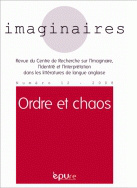D. Thomieres, " Chaos and Literature : Twelve easy introductory propositions " ;
N. Batt, " Literary texts and non-linear dynamical systems " ;
J.H. Christianson, " Things fall apart, & fold back : Tense communions of wholeness & ruin in modern narrative " ;
S. Coelsch-Foisner, " Shape-shifting between Chaos and Order " ;
M. Cunin, " "Like to a chaos" : l'ordre du chaos dans Richard III de William Shakespeare " ;
L. Teyssandier, " La mise en scène du chaos dans le diptyque Antonio and Mellida et Antonio's Revenge de Marston " ;
D. Miller, " The Arbitrary and the Absolute : the Fall into Meaning in Paradise Lost " ;
H. Dachez, " Curse, Cross and Corpse : Blood Ties in Samuel Richardson's Clarissa; Or, the History of a Young Lady (1747-1748) " ;
A.L. Perotto, " The Private Memoirs and Confessions of a Justified Sinner de James Hogg, ou la perpétuelle remise en ordre du réel " ;
J. Fromonot, " Ordre et chaos dans Martin Chuzzlewit, de Charles Dickens : il faut sauver l'hypocrite Pecksniff " ;
T. Monterrey, " Chaos Framed, or the Ekphrastic Rendering of Transcendental Mysteries in Narrative " ;
N. Marsaleix, " Figures et figurations de l'ordre et du chaos dans Jacob's room de Virginia Woolf " ;
C. Marie, " "From chaos and cacophony measure" : didactique du chaos dans Between the Acts de Virginia Woolf " ;
I. Keller, " "The signs of a new chaos" : l'exploration d'une réalité nouvelle dans The Black Book de Lawrence Durell " ;
M. Fraschi, " "Smiling on chaos" : Occult Patterns and the Random Accumulation of Junk in Iain Sinclair's Downriver " ;
N. Leorat, " De l'aveuglement au discernement : voyage à travers le chaos dans l'avant-dernier roman d'Ian MacEwan Atonement (Expiation) " ;
L. Tayeb, " The Postmodern Intention : Writing and Chaos in Michael Ondaatje's Anil's Ghost " ;
S. Vincent-Prabakar, " Reimagined Chaos and Order in Salman Rushdie's the Ground Beneath her feet " ;
E Muller, " Reshaping CHAOS : Platonic Elements in Yeats's A Vision and later poetry " ;
Y. Bellenger-Morvan, " La restauration de la Loi dans les Narnia Chronicles de C.S. Lewis " ;
C. Chollier, " Ordre et chaos sémantiques dans The Grapes of Wrath de Steinbeck " ;
D. Thomières, " Quelques variations sur le cadre et l'erreur : la répétition et la différence dans The Optimist's Daughter de Eudora Welty " ;
Y. Rivière, " Ordre & chaos comme ressorts dramatiques dans Who's Afraid of Virginia Woolf ? d'Edward Albee (1962) " ;
C. Chauche, " Beloved, a Principle of Order and Chaos in Toni Morrison's novel Beloved " ;
G. Jones, " Chaos and Complexity in Paul Auster's New YorkTrilogy ".

